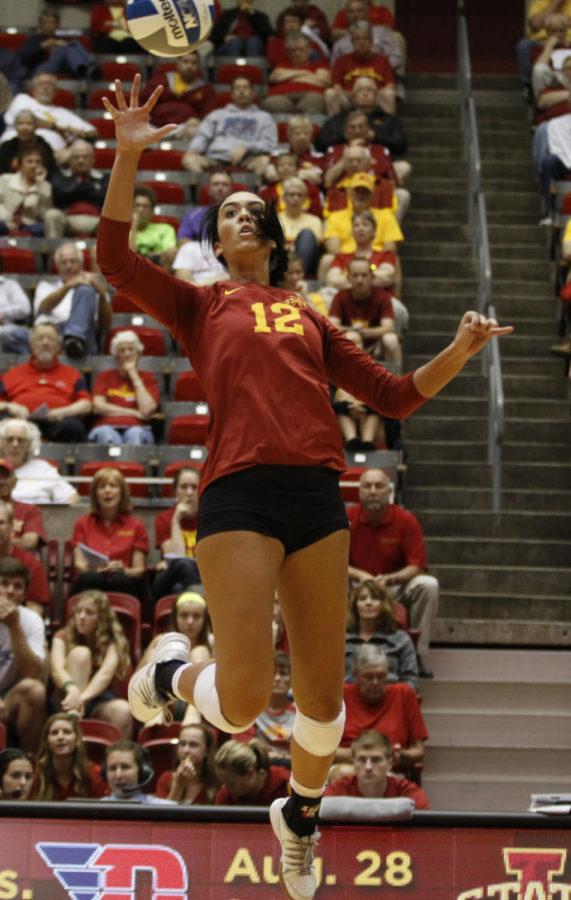Blocking leads ISU volleyball to victory against Oklahoma
Redshirt senior Tory Knuth (12) jumps up to spike the ball during Iowa State’s match against North Dakota on Wednesday, Aug. 29 at Hilton Coliseum. The Cyclones defeated the Fighting Sioux, 3-1.
October 31, 2015
For a team ranked worst in the Big 12 for blocking, Iowa State certainly did not show it on Oct. 31.
Iowa State (14-7, 7-3 Big 12) defeated Oklahoma (8-13, 2-7 Big 12) in four sets Saturday, led by a season-high 13.0 blocks on the match. Sophomores Alexis Conaway and Monique Harris led the charge with six and four blocks, respectively.
Prior to the match, the Cyclones averaged 1.90 blocks per set — the worst in the conference. Against Oklahoma, however, the Cyclones managed 3.25 blocks per set, notching 4.5 in the first. The 13.0 total blocks boosted the team’s average on the season to 1.96 per set.
“I think [our blocking] is getting better,” Conaway said. “It’s really just focusing on the simple things: pressing over, reaching to get that extra inch and just being straight up.”
@CycloneVB takes set 1 25-22! Tune in for Set 2 on https://t.co/2zCC7hAB7h https://t.co/kZ3Oujnh63
— Cyclones.tv (@CyclonesTV) October 31, 2015
One of Iowa State’s leading blockers on the afternoon was one of its shortest players — Mo Harris. She recorded a season-high four blocks and almost notched a fifth per a Johnson-Lynch challenge that was upheld.
In the 5-1 formation, Harris has the freedom to block and attack from the front row — something she was unable to do in the 6-2. And as the Cyclones saw against the Sooners, Harris’ 5-foot-6-inch demeanor has not inhibited her from establishing her presence at the net.
“I think people try to go after her,” Johnson-Lynch said. “But she surprisingly does a pretty nice job blocking.”
Along with Harris and Conaway, redshirt senior Tory Knuth contributed to the ISU blocking effort. Johnson-Lynch subbed Knuth in for the first time midway through the third set, and Knuth made an immediate impact, defensively and offensively.
She notched two blocks and added three kills and an assist in two sets of action. Knuth has seen her playing time drop off since her redshirt sophomore season — playing in just 11 matches before Saturday — but Johnson-Lynch had confidence in her decision to sub in her veteran middle blocker.
“She’s a great blocker,” Johnson-Lynch said. “She’s an elite blocker. So I thought she could help us there. Her arm had a little more pop to it at this time last year, and I see the same thing happening this year.”
When Iowa State’s blocks did not lead directly to points, they extended plays. The Cyclones were tipping or returning attacks frequently, especially early on in the match. These tips, from both sides, led to easier digs and longer rallies.
Both sides seemed to slow down their opponent’s attacks early on — contributing to a back-and-forth defensive battle. The first set alone saw 12 ties and five lead-changes. It was the Cyclones’ defense that eventually prevailed, however, holding the Sooners to a sub .200 hitting percentage on the match.
“Both teams we’re really great defensively,” Harris said. “Just continuing to keep the ball alive really showed the effort and motivation that [both] teams had.”
Although the Sooners out-blocked the Cyclones in their first matchup on Sept. 30, it was Iowa State this time, in the true spirit of Halloween, that “haunted” the Sooners at the net.







